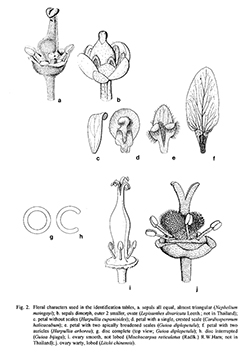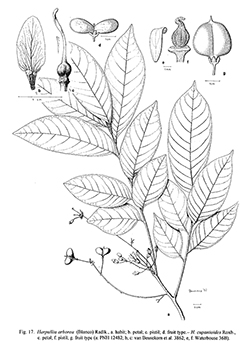e-Flora of Thailand
Volume 7 > Part 1 > Year 1999 > Page 209 > Sapindaceae > Harpullia
1. Harpullia arborea (Blanco) Radlk.wfo-0000715815
Sitzungsber. Math.-Phys. Cl. Königl. Bayer. Akad. Wiss. München 16: 404, 1887; in Engl., Pflanzenr. 98: 1456. 1934; Leenh. & Vente, Blumea 28: 11, fig. 1c. 1982 (see also for complete synonymy); Yap in Tree Fl. Mal. 4: 444. 1989; Leenh. & Vente in Fl. Males., Ser. 1, Spermat. 11: 601, fig. 45, 46a–f. 1994.— Ptelea arborea Blanco, Fl. Filip. ed. 1: 63. 1837. Fig. 2f. Fig. 17a–d.
Accepted Name : This is currently accepted.
Description : (Shrubs or) trees up to 33 m high, bark grey, smooth to pustular; young parts and young rachis densely pilose. Leaves 2–6-jugate. Leaflets ovate to elliptic, 5.5–30 by 2–10 cm, herbaceous; base cordate to acute to rounded; apex rounded to acute (to acuminate); glabrous to subpilose on both sides. Inflorescences up to 35(–60 in fruit) cm long. Flowers white, up to more than 1 cm wide. Sepals ovate to obovate, 5–10.5 by 3–5 mm, light green. Petals obovate, membranous; 5 mm long or longer, claw 3–7 mm long, white to light yellow; auricles present. Stamens 5(–7); filaments 10–17 mm long, light green; anthers 2–2.5 mm long, light orange. Fruits red, stipe up to 4.5(–7) mm high, lobes longer than high, (sub) pilose outside, glabrous to subpilose within, wall thin, leathery. Seeds shiny brown to black; sarcotestal ring up to 2.5 mm wide, orange.
Thailand : NORTHERN: Chiang Mai (Doi Chiang Dao), Lamphun (Doi Khun Tan NP), Lampang (Ngao), Phrae (Huai Mae Kami, Huai Rong, Huai Tuam, Prai), Tak (Ban Tung Na Noi, Mae Sot), Sukothai (Ramkhamhaeng NP, Soke Pra Ruang Falls); NORTH-EASTERN: Loei (Pak Chom Forest); SOUTH-WESTERN: Uthai Thani (Huai Kha Khaeng, Katatak, Nong Chang), Kanchanaburi (Erawan NP, Huai Ban Kao, Ow Ngo River, Si Sawat), Prachuap Khiri Khan; CENTRAL: Saraburi (Muak Lek, Phukae, Tham Pra Photisat); PENINSULAR: Trang (Khao Chong).
Distribution : Sri Lanka, India (Deccan Peninsula, Assam), from Thailand, S Vietnam to Australia (N Queensland, the Philippines – type) and the Pacific (Tonga and Samoa).
Ecology : Usually in well-drained primary and secondary evergreen to deciduous forests. On ridges, slopes, and plains, in ravines and sometimes along or in swamps, on river banks, or coastal, soil fertile, often limestone or volcanic, sea level up to 1,200 m alt. Flowering and fruiting throughout the year.
Vernacular : Hang kaen (หางแก่น), hom klai dong (หอมไกลดง), krapok ma (กระโปกหมา)(Northern); krapok ling (กระโปกลิง)(Northeastern, Central).
Uses: The bark is used as fish poison. A watery exudate of the bark and sometimes the fruits is used for washing, to keep away leeches, or is drunk to allay pain. The oil pressed from the seeds may be anti-rheumatic.


